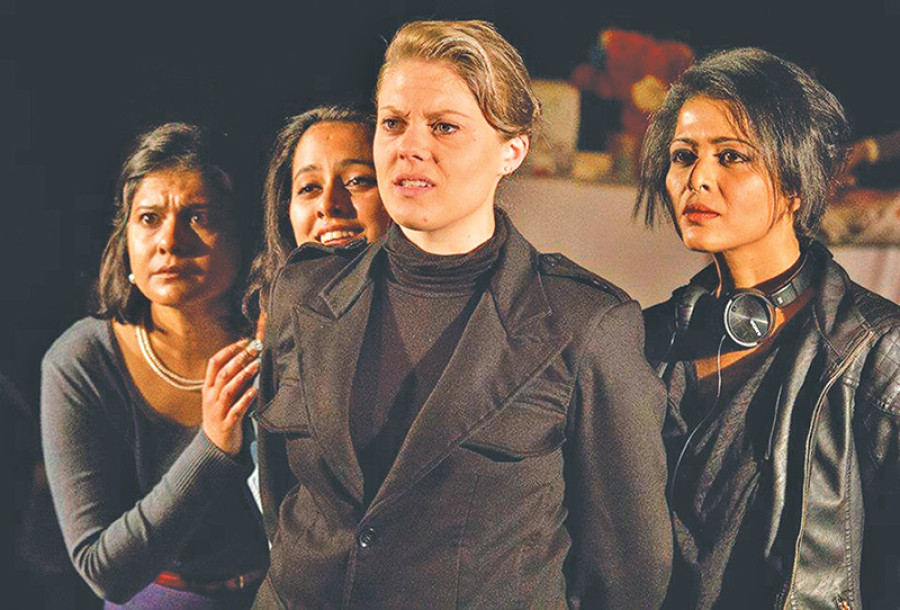Entertainment
The other world
The ongoing staging of Anton Chekhov’s Three Sisters (directed by Rose Schwietz at Kunja Theatre) provides an opportunity to explore the relevance of 19th century Russian literature in present day Nepal.
Sandesh Ghimire
The ongoing staging of Anton Chekhov’s Three Sisters (directed by Rose Schwietz at Kunja Theatre) provides an opportunity to explore the relevance of 19th century Russian literature in present day Nepal.
Written towards the end of Chekhov’s life, Three Sisters revolves around the life of Olga, Masha, and Irina—the three sisters—who lead comfortable aristocratic lives in a small provincial garrison town, somewhere in Russia.
After their father’s death, the family has lost government supplies amenities, but they have managed—without any difficulties—to continue living in luxury. The sorrow from the death of their father has already receded into memory, and the family is ready to celebrate Irina’s birthday. Yet, there is a sense of desperation looming over the sisters.

They report that the provincial town is limiting; their talents are not appreciated, and they are stupefyingly lonely.
For them, the solution to their agony is to relocate to Moscow, where “you might be alone, but you can never be lonely.” However, it is not just the sisters who hope to move to Moscow. All 16 characters seemed to have dreamt—in one way or another—of being in Moscow. When work is dull or when a fire engulfs their town, a move to Moscow appears as a panacea to their problems.
We, the Nepali people, are similar to the three Russian sisters, because we too harbour a similar aspiration. A person in Taplejung believes that living in Jhapa might solve all his crises, while another in Jhapa might hope that a similar migration to Kathmandu will end all her life’s qualms.
We might justify our present form of migration as a necessary move to upgrade our material standard of living. So, in a hope of the grandest fulfilment of our consumerist desires, we have aspired to make the final stretch to a western nation, or at least to play ‘catch up’ with the western way of life.
But the increasing flow of westerners who arrive in Nepal seeking to fulfil the spiritual ‘bankruptcy’ in their lives, indicates that the potential rise in standard of living is not the only factor that determines the imposition of such self-exile.
It is not always a concrete idea or ideal that becomes the driving force for an émigré. It can simply be an act of escaping our surrounding, because no amount of sophistication can decrease the friction between dreams and reality. In the play, Moscow is depicted as a city of dreams, a kind of magic potion that has led to fetishism which, in turn, manifested strange notions and unnecessary brawls.
Being in Moscow for Irina means finding a suitable husband while, an old man who knows that he will never be able to go to Moscow has come to believe that a “big rope is tied from one end of Moscow to the other end.”
In another scene, two men start fighting because they cannot agree whether there are one or two universities in Moscow. Similarly, every single character has their own projection of what they would find in the Russian capital.

The play ends without any of the characters getting to Moscow, the same way, perhaps, our lives end without us ever witnessing the fulfilment of our desires.
This resonance of provincial thinking in Nepali lives makes the staging of the Chekhov’s play a timely reminder to introspect our own lives—but this is one interpretation of the play, and there are other ways of interpreting the play from a Nepali vantage point.
Because the play provides the framework to examine our own lives, the staging also makes a case for the need to bring more classical plays to the stage more frequently.
A justification for bringing plays of the calibre of Three Sisters can be found in the play itself: Despite the advancement of technology, and material abundance, “Human life might not be very different three hundred years from now,” as one of the characters reflects during a sombre moment, “our fears and desires will remain the same.”
At a time when most of the original productions lack the depth in storytelling, classical plays will serve as a paragon for the kind of creation that artists need to aspire to. Furthermore, a staging of a classic will provide the link to explore other canonical works of world literature.
Despite the boom in theatrical activities, the theatre going audience seems to largely consist of insiders: the artists, their friends, and families, along with journalists. People are in the theatre to either pat the back of their friends, or to find content to fill the columns of their newspapers. There are very few people who frequent theatre houses to revel in a work of art. But the ongoing staging of Three Sisters shows that theatre—as an art form—has the potential to ignite a larger societal conversation.
It is not the case that Three Sisters is a perfect production. Several technical issues can be pointed out, but there is value to such criticisms only when more people visit theatre houses with the same enthusiasm they go to a shopping mall.
The play will continue until March 18 at Kunja Theatre, Baneshwor.
(Photos courtesy: Kanishka Das Gupta)




 9.12°C Kathmandu
9.12°C Kathmandu










